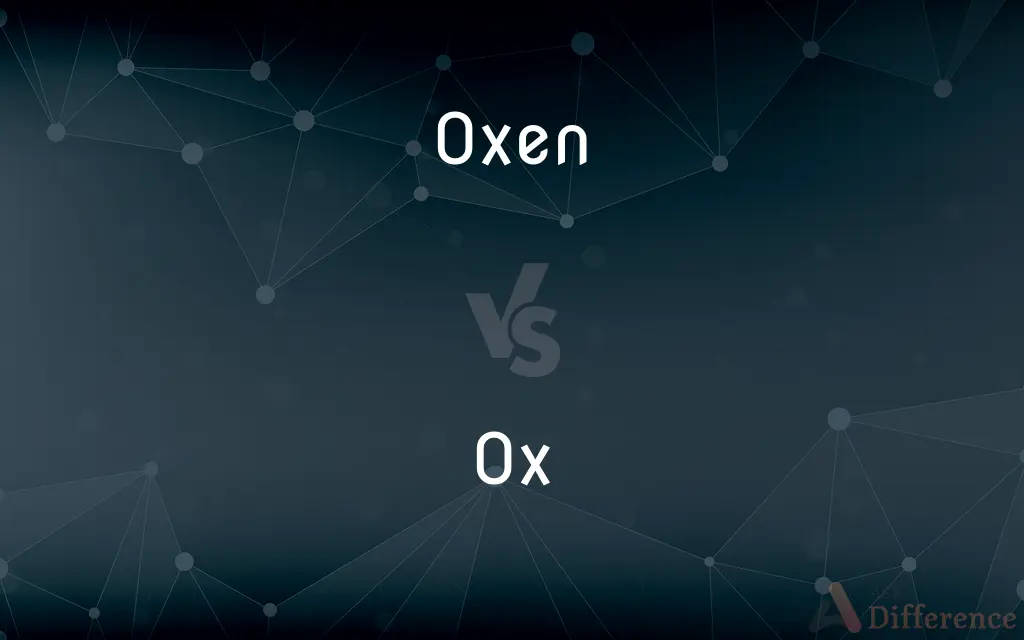Oxen vs. Ox — What's the Difference?
By Tayyaba Rehman — Updated on November 4, 2023
Ox is a singular term for a bovine animal typically used for labor; oxen is simply the plural form of ox, indicating more than one.

Difference Between Oxen and Ox
Table of Contents
ADVERTISEMENT
Key Differences
Oxen and ox are terms deeply rooted in agricultural societies. An ox is a single bovine creature, usually a castrated male, trained as a draft animal. Oxen are these animals in the plural form, denoting a group of ox. In the English language, the transition from ox to oxen is an example of an irregular plural form, where the typical 's' is not used to denote plurality.
The word ox traditionally conjures images of a powerful animal used for plowing and farming. Oxen, the plural, implies a team of such animals working together, often yoked in pairs. When one refers to an ox, it is a singular reference, while using oxen indicates that there is more than one ox present. Despite the difference in number, both words convey strength and endurance.
In literature and historical texts, an ox is a symbol of labor and patience, often celebrated for its strength and diligence. Oxen, on the other hand, are commonly referred to when discussing the collective effort, as they were historically used in teams to accomplish agricultural tasks. Although both the singular and plural forms point to the same type of animal, the context in which they are used can highlight either individual contribution (ox) or teamwork (oxen).
In grammar, 'ox' and 'oxen' provide an example of how English forms plurals in different ways. An ox is one, while oxen means two or more. This distinction is critical when quantifying these animals or referring to them in text. The use of 'ox' or 'oxen' must match the number of animals being described to maintain grammatical accuracy.
Comparison Chart
Number
Plural form, indicating more than one ox.
Singular form, indicating one animal.
ADVERTISEMENT
Usage in Sentences
Used when referring to multiple animals.
Used when referring to a single animal.
Grammar
Irregular plural form of ox.
Standard singular noun.
Etymology
Old English "oxan", always used for plural.
Old English "oxa", used for singular.
Agricultural Use
Refers to groups of oxen working together.
Refers to an individual ox at work.
Compare with Definitions
Oxen
Plural form of ox, used for multiple draft animals.
The farmer relied on his oxen to plow the fields.
Ox
A singular term for a bovine beast of burden.
The ox rested in the shade after a long day of work.
Oxen
Multiple ox animals collectively harnessed or penned.
The oxen bellowed in the barn as the storm approached.
Ox
A single draft animal, typically a castrated male cow.
An ox can pull a cart or a plow on its own.
Oxen
Several castrated male cattle trained for work.
Oxen were essential for farming before the advent of machinery.
Ox
One member of the species used historically for plowing.
The lone ox has been part of farm life for centuries.
Oxen
Groups of bovines commonly used in agricultural settings.
Oxen are stronger together when yoked in pairs.
Ox
An individual cattle creature trained for heavy tasks.
The ox moved slowly but steadily with the load.
Oxen
The collective term for more than one ox used in labor.
Teams of oxen were used to pull heavy loads.
Ox
A castrated male of the bovine species, working solo.
The farmer hitched the ox to the mill wheel.
Oxen
Plural of ox.
Ox
An ox (plural oxen), also known as a bullock (in BrE, AusE& IndE), is a male bovine trained and used as a draft animal. Oxen are commonly castrated adult male cattle; castration inhibits testosterone and aggression, which makes the males docile and safer to work with.
Oxen
Plural of ox
Ox
A domesticated bovine animal kept for milk or meat; a cow or bull
He was tall and broad and as strong as an ox
Oxen
Of, relating to, or resembling an ox; oxlike
Ox
An adult castrated bull of the genus Bos, especially B. taurus, used chiefly as a draft animal.
Oxen
Domesticated bovine animals as a group regardless of sex or age;
So many head of cattle
Wait till the cows come home
Seven thin and ill-favored kine
A team of oxen
Ox
A bovine mammal, especially one that has been domesticated.
Ox
An adult castrated male of cattle (B. taurus), especially when used as a beast of burden.
Ox
Any bovine animal (genus Bos). A neat, a beef.
Ox
Abbreviation of oxygen
Ox
The male of bovine quadrupeds, especially the domestic animal when castrated and grown to its full size, or nearly so. The word is also applied, as a general name, to any species of bovine animals, male and female.
All sheep and oxen, yea, and the beasts of the field.
Ox
An adult castrated bull of the genus Bos; especially Bos taurus
Ox
Any of various wild bovines especially of the genera Bos or closely related Bibos
Common Curiosities
What is an ox?
An ox is a castrated male bovine animal used for draft work.
Is the singular of oxen 'oxe'?
No, the singular is 'ox,' while the plural is 'oxen.'
What are oxen?
Oxen are the plural of ox, meaning more than one such animal.
Can the word oxen be used for females?
Typically, oxen refers to castrated males, but the term can include females in a work team.
Can oxen be of any breed of cattle?
Yes, oxen can be from various cattle breeds suited for draft work.
Why is the plural of ox 'oxen' instead of 'oxes'?
It's an irregular plural form rooted in Old English.
Is an ox always a draft animal?
Typically, yes; an ox is trained for pulling and carrying loads.
How do you differentiate between ox and oxen in writing?
Use 'ox' for one animal and 'oxen' for multiple animals.
How do oxen work together?
Oxen are usually yoked in pairs to perform tasks more efficiently.
At what age can an ox start working?
Oxen usually begin training at around two years of age.
What's the lifespan of an ox?
An ox can live up to 20 years or more, depending on the breed and conditions.
What is the history behind the word 'oxen'?
'Oxen' comes from Old English and has always been used as the plural of ox.
Are oxen still used today?
In some regions, oxen are still used for farming and transport.
What is the role of an ox in agriculture?
An ox is commonly used for plowing fields and hauling carts.
How long have oxen been used for labor?
Oxen have been used for agricultural labor for thousands of years.
Share Your Discovery

Previous Comparison
Byline vs. Subheading
Next Comparison
Childs vs. ChildAuthor Spotlight
Written by
Tayyaba RehmanTayyaba Rehman is a distinguished writer, currently serving as a primary contributor to askdifference.com. As a researcher in semantics and etymology, Tayyaba's passion for the complexity of languages and their distinctions has found a perfect home on the platform. Tayyaba delves into the intricacies of language, distinguishing between commonly confused words and phrases, thereby providing clarity for readers worldwide.














































